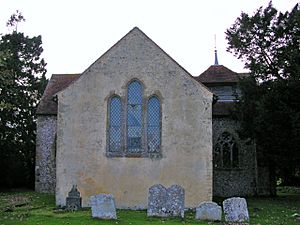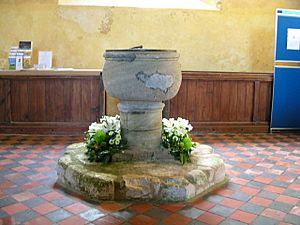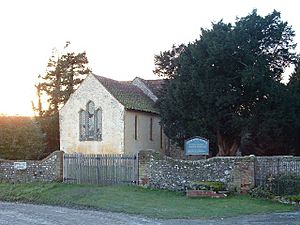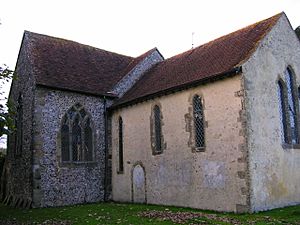St Mary the Virgin's Church, North Stoke facts for kids
Quick facts for kids St Mary the Virgin |
|
|---|---|

St Mary the Virgin church from the east
|
|
| 50°53′15″N 0°33′05″W / 50.8874°N 0.5514°W | |
| Location | North Stoke Church, North Stoke, Amberley, West Sussex BN18 9LS |
| Country | England |
| Denomination | Church of England |
| History | |
| Former name(s) | North Stoke Church (no dedication) |
| Founded | 11th century |
| Dedication | Mary the Virgin |
| Dedicated | 8 December 2007 (rededication) |
| Architecture | |
| Functional status | Redundant |
| Heritage designation | Grade I |
| Designated | 15 March 1955 |
| Style | Norman; Early English Gothic |
| Closed | 1 March 1992 |
| Administration | |
| Parish | Amberley with North Stoke |
| Deanery | Storrington |
| Archdeaconry | Horsham |
| Diocese | Chichester |
The St Mary the Virgin Church is a very old building in the small village of North Stoke, West Sussex. It was once a Church of England parish church. In 2007, its original name, St Mary the Virgin, was rediscovered. This name had been forgotten for hundreds of years!
The church building is from the 11th century. It has a special cross shape, called cruciform. It stands in a quiet village next to the River Arun. What's cool is that it hasn't been changed much over the years. It still looks very similar to how it did centuries ago.
Inside, you can find really old stained glass windows and wall paintings. These show how art and building styles changed over time. The church is no longer used for regular services. In 1992, it was given to the Churches Conservation Trust. This group helps protect important old churches. The church is considered very important for its history and architecture.
A Look Back: Church History
The village of North Stoke is much smaller now than it used to be. It sits across the River Arun from South Stoke. You can walk between them or drive a longer way around.
Early Beginnings: 11th Century
A church was first mentioned here in 1086. This was in the famous Domesday Book. It was probably a wooden Saxon church. Later in the 11th century, the main part of the church, called the nave, was built. It was built on the old church's foundations. This part of the church is tall and wide. It has one window on each side.
Adding to the Church: 13th Century Changes
Around the mid-1200s, a new section was added. This was the chancel, which is the area around the altar. Its windows are tall and narrow, called lancet windows. They show how church windows were starting to change.
About 1290, the church was made into a cross shape. This was done by adding two side sections called transepts. The one on the north side was built to hold a tower. But the tower was never built! Instead, a small belfry was added on the roof. The transept windows have fancy stone patterns. These patterns are called tracery. They show even more changes in window design.
Ancient Stained Glass and Wall Paintings
Around the same time (1290), the church got some small stained glass windows. These windows show the Coronation of the Virgin. This is a very early example of stained glass in Sussex. It shows how glass art was moving towards showing Biblical figures.
In the early 1300s, a special arch was built. This arch separates the nave from the chancel. It is made of a soft stone called clunch. It has detailed decorations. You can still see parts of old wall paintings above this arch. These paintings show flowers and leaves.
Preserving the Past: No Victorian Changes
Many churches in Sussex were changed a lot in the 1800s. This was called Victorian restoration. But North Stoke Church was mostly left alone. This means its simple wooden roof is over 700 years old! You can still see the old timber beams inside.
A New Purpose: The Churches Conservation Trust
On March 1, 1992, the church was declared "redundant." This means it was no longer used for regular worship. It was then given to the Churches Conservation Trust. This group takes care of old churches that are no longer active. The church is open for visitors every day.
In 2007, something exciting happened. Two people studying old church history found an old document. It was a letter from 1275. This letter showed that the church was dedicated to Mary the Virgin. This name had been lost for centuries! So, on December 8, 2007, the church was officially renamed St Mary the Virgin Church.
Church Design and Features
St Mary the Virgin Church is a simple building. It was built in three main stages. The main part (nave) is from the 11th century. The chancel was added in the early 1200s. The two side sections (transepts) were built later in the 1200s. The church is made from local flint and stone.
Inside the Church: Simple Beauty
The inside of the church is simple and bright. It has mostly clear glass windows and white walls. It feels like stepping back in time. The wooden roof has exposed beams. The arch separating the nave and chancel is very decorative.
One special thing about the church is its windows. They show how window styles changed over hundreds of years. You can see narrow Norman windows. Then there are taller Early English Gothic windows. And later, windows with fancy stone patterns. There are six different window styles in total! Most of the glass is clear. But the stained glass that remains is very old and in good shape.
Old Fittings and Monuments
The church has some very old fittings. There's a piscina from the mid-1200s. This was a basin used for washing sacred vessels. It's connected to three seats called sedilia. Above these, you can see two blocked archways. They meet at a stone carving of a sheep's head.
There are also six stone slabs on the chancel floor. These are from the late 1600s and early 1700s. A marble tablet remembers members of the Sayres family from the early 1800s. The churchyard has very few gravestones. But three old ones with carved crosses are from the late 1200s.
The Ancient Font

The oldest item in the church is a stone font. It looks like a tub. It was made between 1200 and 1250. It stands at the west end of the church. The font is wide and sits on a thin pillar. It has very little decoration. It was carved from sandstone found nearby.
See also
- Grade I listed buildings in West Sussex
- List of churches preserved by the Churches Conservation Trust in Southeast England
- List of places of worship in Horsham (district)




